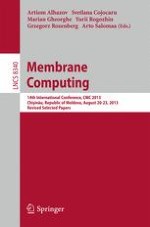This book constitutes the thoroughly refereed post-conference proceedings of the 14th International Conference on Membrane Computing, CMC 2013, held in Chişinău, Republic of Moldova, in August 2013.
The 16 revised selected papers presented together with 6 invited lectures were carefully reviewed and selected from 26 papers presented at the conference. Membrane computing is an area of computer science aiming to abstract computing ideas and models from the structure and the functioning of living cells, as well as from the way the cells are organized in tissues or higher order structures. It deals with membrane systems, also called P systems, which are distributed and parallel algebraic models processing multi sets of objects in a localized manner (evolution rules and evolving objects are encapsulated into compartments delimited by membranes), with an essential role played by the communication among compartments and with the environment.
